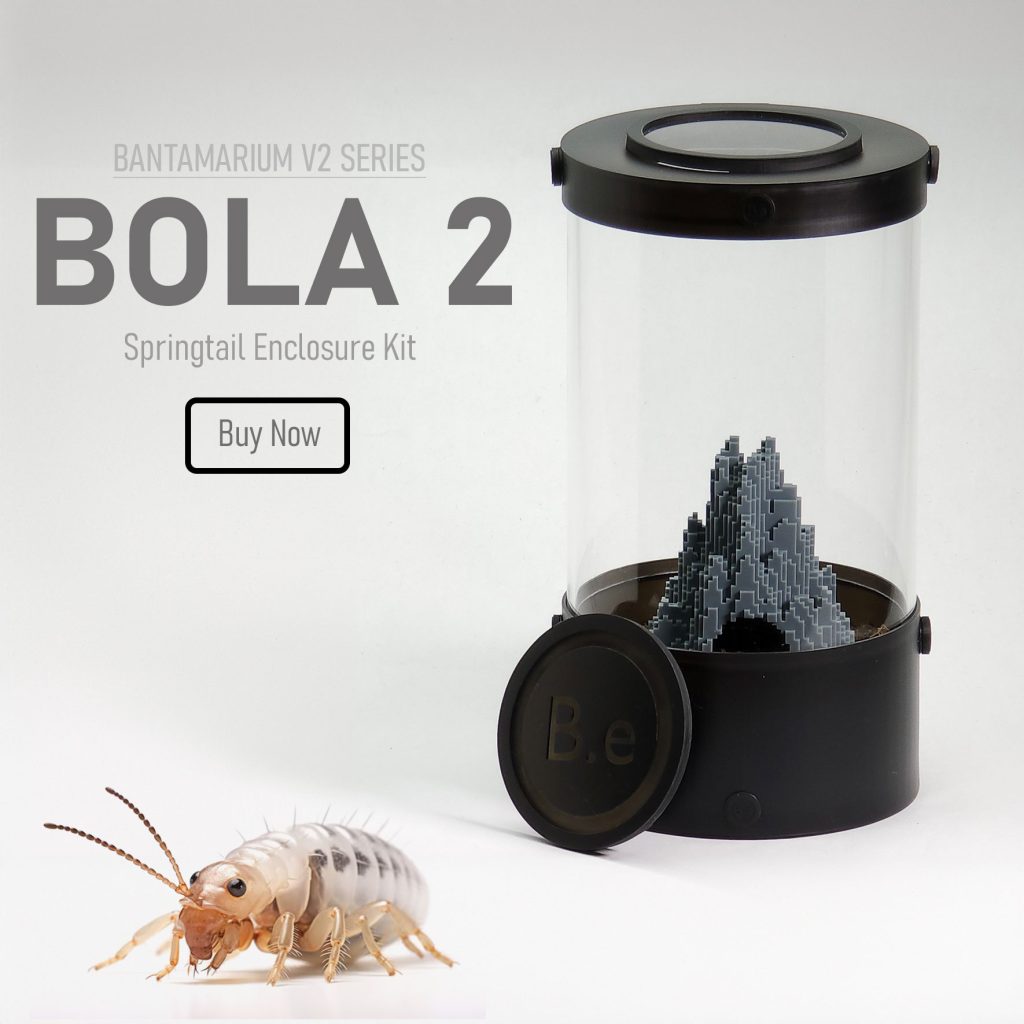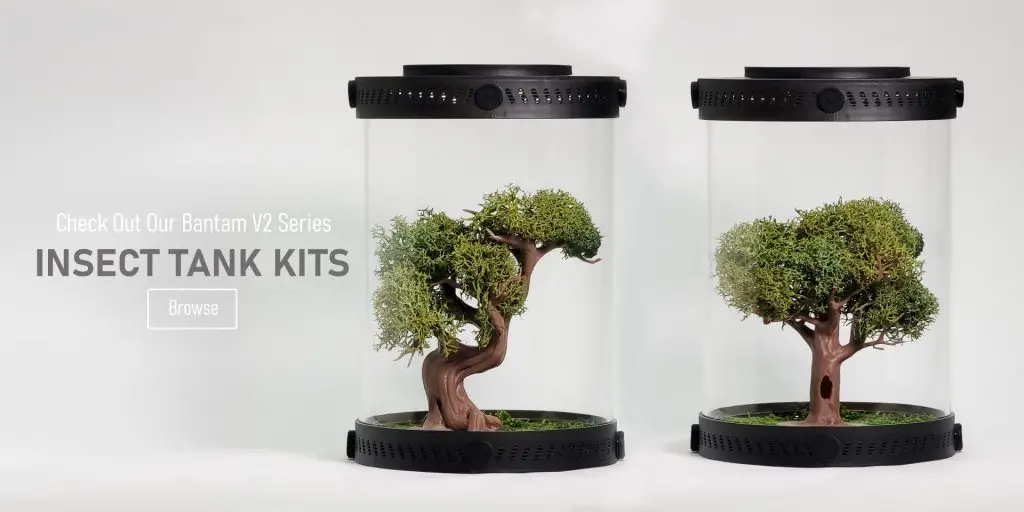Are you looking for a simple way to transform your terrarium into a self-sustaining, bioactive vivarium? Introducing springtails in terrariums could be just the thing for you!
These tiny and often overlooked invertebrates are incredible animals and are considered the smallest pets you can have. They provide natural soil cleaning activities, improve nutrition for plants, and protect terrariums from harmful disease-causing organisms.
In this article, we’ll explore what springtails are and why they’re ideal for terrariums. We will also cover the best kinds of springtails and types of terrariums for them, and how to introduce and manage them.
Table Of Contents:
ToggleBest Springtails For Terrariums
When considering springtails, it is important to keep in mind that some species are better suited for terrariums than others.
Folsomia candida, also known as springtails (collembola), is one of the better types for terrariums, as it is a resilient, hardy species that does not reproduce too rapidly.
This species is also tolerant of a wide range of temperatures and can tolerate adjustments in levels of light and moisture.
Another factor to consider is their size – Folsomia candida falls into the category of ‘micro arthropods’, meaning they measure less than 3 millimeters in length.
This makes them difficult to see with the naked eye and can help prevent overpopulation.
Click the image below to learn more about these particular springtails.
Best Type Of Terrariums For Springtails
The type of vivarium you choose for springtails depends in part on the types of springtails you plan to introduce. Folsomia candida does best in closed tropical terrariums and paludariums.
A key feature to look for in the best type of vivarium for springtails is humidity. As moisture-loving small invertebrates, springtails generally prefer humid conditions with some standing water and lots of damp, moist soil.
For this reason, open or arid terrariums may not be ideal. However, if you do opt for an open terrarium, then you should pay extra attention to moistening the substrate and maintaining humidity.
For an optimal setup, consider our Customizable Springtail Terrarium Kits, which includes everything you need to create a thriving springtail habitat.
Best Substrate For Springtails
The substrate you choose for an enclosure is essential for any springtail-friendly habitat. Substrates should be moisture-retaining but also well-aerated. Three great substrates commonly used for springtails are standard terrarium soil mix, clay, and activated carbon.
- Clay is lightweight and easy to work with, making it great for creating just the right environment for springtails.
- Activated carbon provides excellent moisture retention and is also proven to filter out impurities and toxins from the soil. It also works best for odor absorption.
- Terrarium soil mix is perfect for providing both the moisture and aeration levels springtails need. Additionally, it’s rich in minerals and organic materials which act as an important food source for many species of springtails.
Our Springtail Substrate Blend is specially formulated to provide the ideal conditions for springtails, ensuring they have the perfect habitat to flourish in your terrarium.
When choosing a substrate for springtails in terrariums, be sure to look for stable, nontoxic materials. Substrates like terrarium gravel should be avoided as they can easily get too dry, affecting the humidity levels and making them unsuitable for springtails.
Additionally, it’s important to take into account the overall climate you’re aiming to recreate in the terrarium before selecting the substrate.
Best Plants For Springtails
When choosing terrarium plants for a terrarium with springtails, there are several key things to keep in mind. Firstly, aim to strike a balance between easy-to-care-for and easy-to-clean plants.
Some of the most popular and best plants for springtails include Ferns, vines, and moss. These tropical terrarium plants thrive in terrariums and tend to produce little waste, so they can help keep your springtails healthy and happy.
When selecting plants for your springtail terrarium, consider their natural habitat and try to choose species that are native to the area.
Also think about their requirements for proper terrarium lighting and watering, as these can vary from plant to plant. And finally, since springtails are small and delicate, look for plants with sturdy stems and gentle leaves.
In terms of overall climate, any terrarium with springtails should have plenty of moisture and humid air.
Adding a diverse collection of closed terrarium plants is a great way to achieve this, as it not only helps create an environment similar to the springtails’ natural habitat but also provides extra nutrition for them.
Introducing Springtails To A Terrarium
Learn how to properly place the springtails in your terrarium, give them access to food and nutrients, and monitor their activity. With just a few simple steps, you will be able to experience the joy of having your very own springtail culture!
Using our Customizable Springtail Terrarium Kit simplifies this process, providing you with all the necessary components to establish a successful springtail colony.


Materials:
Steps to a successful springtail culture
Managing Springtails In Terrariums
Managing springtails in terrariums requires a few simple steps. Keeping their environment at the right moisture and humidity levels is important to ensure they thrive.
As we covered earlier, springtails should be provided with a nutrient-rich substrate. The population will adapt depending on the available food source.
Moisture & Humidity
Moisture and humidity levels are important factors to consider when managing springtails in terrariums.
A humidity level of between 80-85% should be maintained, and this can be achieved by misting the terrarium with a spray bottle regularly, adding a humidifier, using heating elements such as lamps, or using a special container to trap and store water.
The substrate should also be kept moist at all times; this may require occasional waterings and regular misting, depending on the type of substrate used.
If the humidity level gets too low, the springtails may start dying off; if it gets too high, the springtails could become susceptible to fungus, which can cause death.
Feeding & Supplementation
Feeding and supplementation are essential for springtails in terrariums. In addition to the nutrient-rich substrate, springtails require additional foods like biofilm or other organic matter they can feed on.
Supplementing their diet with a tailored springtail food meal can help provide the micro-nutrients they need in the right quantities.
Allowing moderate populations of beneficial invertebrates such as mites or springtails to live in the terrarium can also help promote healthy gut bacteria and protect plants from pests and disease.
Click the image below to learn more about my DIY springtail food recipe and best choices.
Identify & Treat Diseases
Identifying and treating diseases or pest infestations is essential for managing springtails in a terrarium.
Keep an eye out for white spots, mites, and any other foreign organisms in the terrarium that could be harming the springtails.
If a disease or infestation has been identified, it’s important to act quickly and isolate the infected springtails in a separate container and treat them using an appropriate pesticide or fungicide.
Once the disease or infestation has been treated, the springtails can be reintroduced to the terrarium to help keep it healthy and balanced.
Conclusion
In conclusion, springtails are a wonderful addition to any terrarium, providing natural cleaning and protective benefits that make terrariums easy to maintain and enjoyable to keep.
Choosing the right type of setup for springtails in terrariums may take a bit of research, but the results can be incredibly rewarding. With the right tools, guidance, and a bit of patience, you too can create a thriving, beautiful terrarium that you can be proud of.
Enhance your terrarium setup with our species-specific soil mixes and Insect Enclosure Kits for optimal results. Create a thriving, balanced ecosystem with ease.
Frequently Asked Questions
In a terrarium, springtails typically eat decaying organic matter, such as fungi, bacteria, mold, and algae. They may also feed on pollen, leaf litter, and decaying leaves.
Yes, springtails eat mold in terrariums. They feed on decaying organic matter and help to keep the terrarium clean. Springtails also help aerate the soil and can help control fungal numbers.
No, springtails are beneficial as they will consume decaying organic matter as well as mold and fungi, but they are not essential.
No, springtail colonies self-regulate depending on the consumable resources available to them. If there’s a lot of food, they multiply. As food becomes scarce, the population will decrease.
Yes, springtails can breed in a terrarium. They reproduce quickly and easily in the moist environment of a terrarium. To encourage springtail breeding in a terrarium, keep the temperature and humidity stable, provide food and water sources for them, and maintain the terrarium.
No, you do not need both isopods and springtails. Isopods and springtails can both be beneficial to terrariums and the ecosystem they create, but they are not essential.
•Springtails help break down organic matter, making them important for decomposition.
•Springtails act as natural pest control, feeding on mites, fungus gnats, aphids, and other soft-bodied pests that can damage plants.
•Springtails add vital nutrients to the soil, such as nitrogen, phosphorus, and potassium.
•Springtails help improve soil structure, retaining moisture and aiding in drainage.
•Springtails are bioindicators and can help monitor environmental conditions.
Springtails need charcoal as a source of calcium and for food. Charcoal also helps them maintain the pH balance and absorb poor odor.
Yes, springtails can live in potting soil. These tiny insects love areas with high moisture and can often be found in abundance in moist soils, mulch, and compost. They are beneficial as they help break down organic matter and keep areas clean.






